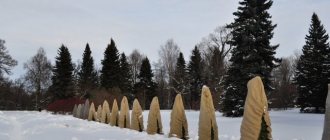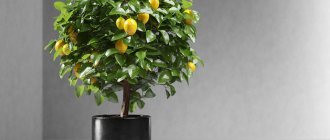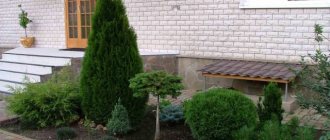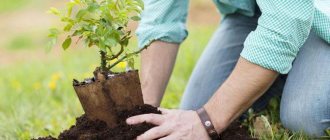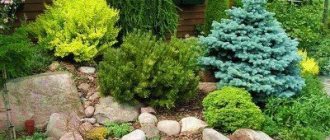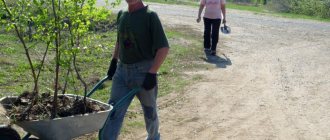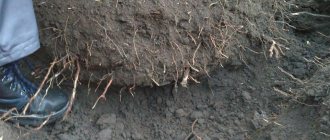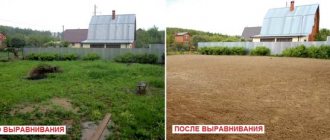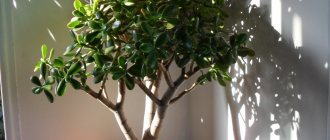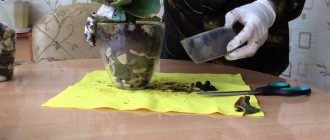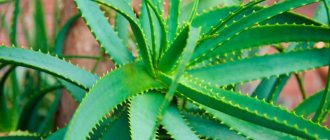Pine is an evergreen conifer, which, despite its large size, can often be found in suburban areas and gardens. But not all gardeners care for the tree correctly; they do not know how to replant a pine tree, what kind of soil the plant needs, and other important details of maintaining a conifer. Therefore, people often harm the plant: it begins to wither and even die.
Is it possible to transplant trees from the forest?
Transplanting wild trees is often accompanied by their death, since they are painfully tolerant of changing conditions. And yet this is possible if you take into account some factors affecting the viability of the tree.
In order for planting pine from the forest to be successful, it is better to do it in early spring or late autumn. During these periods, the pine tree is in a dormant state and does not react so vividly to the changes that have occurred around it.
Planting a tree
Having placed the root ball of the tree in the dug planting hole, we fix the strictly vertical position of the plant trunk. Ideally, you also need to take into account the cardinal directions; the southern part of the tree crown in the new location should also face south. This will help you adapt more quickly to a new place of growth.
When planting, the root collar of the plant should be at the same level as the ground surface. Having fixed the tree, we fill the free space of the planting hole with prepared soil, periodically compacting it. Next, we spill several buckets of water around the trunk of the planted tree.
When is it possible and when is it better to replant pine and spruce trees?
The most successful transplants of coniferous trees from the forest occur either in March-April or in October-November. Spring replanting promotes quick returns - within a month the owners of the site will be able to admire the reviving tree.
However, transplants are more successful in the autumn months.
During winter hibernation, the young pine tree has time to better adapt to new conditions.
How to choose a suitable tree
For transplanting to a personal plot, you should choose low pines. The optimal height of the tree is 60-100 cm. It is important to consider that a small seedling is much easier to deliver to your home. The desired age of the transplanted tree is 3-5 years.
Older trees may not adapt to new conditions, and young pines do not have sufficient viability to easily tolerate transplantation.
Dig out a pine tree with a bayonet shovel, plunging it into the ground at a distance of 50-60 cm from the trunk. You should dig deep enough to avoid damaging the root system. The length of the root is most often identical to the height of the seedling.
A properly dug seedling should have a lump of earth weighing about 20 kg on its roots.
In addition to a shovel, you need to take with you a large piece of cloth and water. Immediately after digging up the seedling, a lump of earth enveloping its root system is wrapped in wet cloth. Otherwise, bare roots may die within 10-15 minutes.
Let's watch a video about replanting a pine tree:
Why do pine needles turn yellow and how to deal with it?
It often happens that pine trees, or rather their needles, suddenly begin to turn yellow (especially in autumn or early spring), but this does not always mean that the tree is sick with something.
Important! Once every 3-5 years, almost all conifers shed their old needles. This is a normal natural process.
The reasons for the yellowing of pine needles can be: improper planting of a seedling or its transplantation: incorrect choice of soil mixture and non-compliance with planting rules, untimely care, namely insufficient watering or excessive fertilizing, as well as spring burn . For example, you need to plant only in fairly loose soil, which must contain sand. The root collar should not be buried. If the weather is dry, you should remember to water the tree and even sprinkle it. For the winter, it is recommended to shade and cover young seedlings.
If you have no doubt that you did everything correctly, then it is quite possible that your tree has contracted a fungal disease (Schütte) or it is the work of pests , which can be gotten rid of with the help of a contact fungicide and an insecticide.
To make your dacha sparkle with new colors and shapes, transplant a young pine seedling to your plot. However, this must be done carefully and wisely, adhering to the recommendations and tips for properly replanting a coniferous tree.
Video: how to transplant a small pine tree to your plot
Where is the best place to plant pine?
To plant a pine tree from the forest on your personal plot, you should carefully choose a suitable location. You should not dig a hole for a young tree in a place exposed to the winds. Pine is a forest tree, and drafts are not a common occurrence for it.
Young seedlings transferred to unusual conditions are especially sensitive to gusts of cold wind. The location for the pine tree should be fairly quiet, but bright. Needles can be planted in the garden next to fruit trees or near a house, the walls of which will protect it from drafts.
However, you should not plant pine closer than 5 meters from the wall. As the tree's root system develops, it can destroy the foundation.
It is advisable to choose a place with a slight slope. It is also important to remember the distance. There should be a distance of at least 2.5 meters between trees. If you plan to grow a tall pine tree, you should retreat at least 4.5 meters from other trees.
Pine and spruce trees actively take all the moisture from the soil. Other plants do not take root under such trees. It is advisable to take this fact into account before choosing a future site for planting.
Black soil, ideal for fruit trees, is completely unsuitable for needles. Pine needs sandy soil to provide drainage for its root system. It is important to consider the level of groundwater in the area.
If underground rivers are close enough to the surface, the tree may die a few years after transplantation. This is due to the fact that its deepened root system will begin to rot.
Location rules
A sunny place on a hill without swamps will be optimal. It is best to plant conifers around the perimeter of the site. If you decide to plant several pine trees at once, then the interval between them should be from two to four meters. The tree has a powerful root system and is capable of turning up layers of earth, destroying paths, and damaging the foundation. Therefore, pine trees are not planted near houses or other buildings.
A pine tree can also be struck by lightning and the resinous plant will light up like a match. This is another reason why you should not replant it near your home. The fire will easily spread to the plant and cause a fire. According to fire safety rules, conifers are placed no closer than ten meters from the house or outbuildings.
Popular: Basic methods of pear grafting for a large harvest
When placed on a garden plot, the powerful roots suck out a lot of useful substances from the soil and nothing with a diameter of five to six meters will grow nearby. Fruit trees can be placed next to conifers, provided that the recommended spacing is observed.
Before planting a tree on your site, you should choose the right place. It is necessary to observe the timing of transplantation, the subtleties of transporting seedlings and the rules for caring for pine. These measures affect the adaptation, growth and normal development of pine. The gardener should minimize the time from digging up to transferring the seedling into the ground.
It is important to observe the dimensions of the prepared hole. Its diameter should be 1.5-2 times larger than the roots of the plant. The bottom of the hole is laid out with a drainage layer about 20 centimeters high. Expanded clay and gravel are used as drainage. 0.5 kilograms of humus is laid out on top of it. The next layer is the substrate. The pine root system should not come into contact with humus. The soil should be watered with a solution of water and nitrogen fertilizer. At the rate of 20–30 grams of fertilizer per five liters of water.
If a forest seedling is transferred to a site, the gardener must provide it with conditions similar to life in the forest as much as possible. To do this, you need to pour forest soil into the prepared hole. So, the plant will receive its usual nutrition. When landing, the orientation to the cardinal points is taken into account. It is advisable to plant the pine tree in the same way as it grew in the forest.
You should not bury the seedling too deeply in the hole. It is placed in the middle of the hole. The root collar should be two centimeters above the ground level. After several waterings, the substrate will settle a little and the neck will be almost at ground level. Gradually pour soil from the forest into the hole and tamp it lightly, watering it.
After this, the ground is mulched with pine needles, tree bark, shavings and other natural materials. To prevent the spring sun from burning the tender branches, young pines are shaded by covering them with a burlap cap. You can use an old linen or cotton sheet for these purposes. Purchase covering materials that are available in a specialized store.
Currently reading:
- How to grow Chinese cabbage in open ground
- Using hydrogel in open ground for plants
- Persistent, large harvest of cucumbers after planting them as seedlings
- Timely application of dolomite flour for the harvest
Share the news on social networks
About the author: Victoria Semyonovna Nakhodkina
Leading researcher at the laboratory of vegetable and berry crops, Yakut Scientific Research Institute of Agriculture, Siberian Branch of the Russian Academy of Agricultural Sciences, Republic of Sakha (Yakutia).
Planting a pine tree in autumn from the forest
For a young pine tree you need to dig a fairly large hole. A lump of earth brought on the root system and crushed stone bedding should fit there. The recommended depth is at least 70 cm. A small amount of natural fertilizer - horse or cow manure - can be placed at the bottom of the hole.
Manure must be sprinkled with a layer of soil - otherwise the root system may burn. Gardeners advise using crushed stone for drainage. When planting, the hole is filled with crushed stone to a depth of 15-10 cm. A seedling dug up in the forest should not be stored outside the soil for a long time. It is best to plant the tree on the same day it is dug up. Moreover, they plant a pine tree together with a piece of cloth in which its roots and a lump of earth were wrapped.
Over time, this tissue will rot and further fertilize the soil. Before placing the seedling in the hole, pour half a bucket of water into it.
At the end of planting, the soil around is mulched. Gardeners recommend using forest needles for this - they serve as an excellent natural antiseptic and repel parasites.
If transplantation occurs in the spring, immediately before planting the seedling, add 20-25 g of nitrogen fertilizer to the hole. After 2 weeks, its active components will begin to actively promote the growth of the tree.
Transplantation in the autumn occurs without such feeding, since there is no need to “wake up” a tree ready for hibernation.
The planted tree should be immediately filled with plenty of water. The tree needs to be constantly watered for 7-10 days. If sub-zero temperatures are not expected, the soil around the seedling should always be in the state of a small swamp.
Experienced gardeners advise not to neglect the orientation of the pine tree relative to the cardinal directions. To do this, before going into the forest, you need to take a compass with you and determine the paws pointing north. To avoid confusion, a bright ribbon is tied to them.
When planting a seedling on your site, you should make sure that the same branches are directed to the north.
Let's watch an interesting video about transplanting a pine tree from the forest in the fall:
Place for transfer
Ephedra grows best in sandy and sandy loam soil with an acidity of 5.5–6.5. Experienced gardeners recommend not planting pine in clay soil, saline substrate, or fertile soil. To reduce acidity, soil enrichment with lime is often used. Pine cannot be grown in a wetland where groundwater flows close.
Ephedra should be planted near a fence, fence, alley or house on the estate. A sunny place is better. After transplanting from the forest, the tree is darkened for a while. It is better to plant pine on hillocks or near fruit trees.
Well preparation
Before planting, you need to dig a hole measuring one meter square. If the soil is clayey, then in the hole it completely changes. You can fill the hole with the following composition: two parts of turf soil, one part of humus and the same amount of sand. All ingredients must be mixed until smooth. Then add a glass of ash and two teaspoons of superphosphate to the hole. A drainage layer consisting of expanded clay (crushed stone) is laid at the bottom of the pit.
Transplant procedure
In order for the plant roots to take root faster, they must be additionally treated with “Kornevin” or succinic acid. Treatment should be carried out up to 24 hours before planting. Add 50 grams of nitrogen fertilizer to the prepared hole. Place a seedling in the hole and dig it in so that the root collar is 20 mm deep. above ground level.
The plants are placed in the center of the hole and soil is gradually poured into it, compacting the substrate. A small depression forms near the trunk. It is in this place that you need to pour a bucket of water after planting. Additionally, the top layer of soil is mulched with pieces of coniferous tree bark or wood chips.
Features of transplanting mountain and Crimean pines
Mountain and Crimean pines are quite popular varieties of needles. They are valued for their decorative properties, which are actively used to create various kinds of landscape designs.
Transplanting these varieties has some features:
- light-loving mountain - you can plant it even in a shaded place, it will still take root, although it will not develop as quickly as we would like;
- Crimean - less frost-resistant, and therefore requires more careful protection from frost in winter.
What care does the seedling require?
In the first weeks after transplantation, the seedling requires frequent and fairly abundant watering. You should not flood the tree “up to your ears” once a day. It is better to water it in doses several times a day, constantly maintaining a relatively high level of soil moisture.
If the winter is dry and snowless, the tree needs to be watered even in frosty weather. However, there is no need to fill it abundantly; it is enough to provide a minimum amount of humidity. During this period, the plant is dormant, so there is no urgent need for a large amount of moisture.
If the owners do not plan to grow a tall tree, the pine tree needs to be pruned. All young branches are shortened by a third. A similar procedure is repeated every 2 years. As a result, the site will have dense and lush, but low pine.
For the first 2 years after transplantation, the roots of the seedling should be protected from frost.
This is especially important when it comes to trees transplanted in the fall. The lower part of the trunk and the ground around the seedling are wrapped in spandex or burlap.
Young pine trees need feeding. To do this, seedlings are fertilized with complex mineral mixtures. 1-2 handfuls of fertilizer are thrown under the tree and watered with water for better absorption. The procedure is carried out 2 times a year - in spring and autumn.
Gradually, a litter of crumbling needles forms under the tree. Under no circumstances should it be removed. This “carpet” serves as an excellent fertilizer and reliable protection against harmful insects. In addition, coniferous litter retains moisture well.
Which varieties are best to use for garden plots?
To transplant to your site, it is better to choose a specimen from the following varieties:
- Mountain pine (Pinus mugo) is a short tree that can grow anywhere. Its value lies in the fact that it is not too great in itself. And if you pinch the top, you can set the size to which it will grow.
- Familiar to everyone Scots pine (Pinus sylvestris) is also suitable for growing in the garden. Of course, this is a tall tree, but it does not require special care.
- Norway spruce (Picea abies) and Canada spruce (Pyramidata) are also suitable for growing on site. They do not exceed 4 m, have dense greenery and can grow in any conditions.
- European pine (Pinus cembra) is characterized by great fluffiness and density. This small plant is distinguished by the fact that it grows very slowly, and you will have time to enjoy its compact form.
How to plant a pine tree in a pot
A small coniferous tree in the apartment helps purify the air and gives it a pleasant resinous aroma. This home decoration can be purchased at a nursery or flower shop. If you wish, you can try to transplant a small seedling from the forest.
The transplantation procedure is similar to planting a pine tree on a personal plot. The main difference is the choice of pine. The pot requires seedlings of the appropriate size.
Also, the forest guest should be provided with favorable living conditions:
- ensuring low temperatures during wintering. Required parameters - from -7 to 10 degrees;
- an influx of fresh air - a pot of pine should be placed on the windowsill of a window facing north;
- lighting - conifers “do not like” shaded places;
- timely watering. Unlike mature trees growing outside, small pines in pots need constant soil moisture;
- daily spraying with warm (20-25 degrees) water.
Transplanting forest needles to a personal plot is not associated with great difficulties. Pines and spruces are quite unpretentious.
If there is suitable soil and proper care in the first days after transplantation, forest guests successfully take root in the new conditions.
FOREST TREES IN THE GARDEN
Forest trees in a summer cottage often turn out to be the biggest “weeds.” And sometimes the gardener does not understand that his plants are oppressed by nothing more than the roots of giants. Let's try to characterize the main forest plants and point out their positive and negative sides.
Plants such as birch, alder, hazel, maple, ash, poplar can provoke allergies. Spruce and pine are fire hazards in dry, hot summers and their presence near a house is fraught with serious consequences. Juniper is an intermediate host for many fungal diseases of berry crops, and bird cherry attracts aphids.
Birch, spruce, and pine trees have superficial roots, which sometimes even extend outward. And, naturally, they interfere with all plantings. No artificially constructed barriers can save you from the roots. Suffice it to say that birch roots can crack the foundation of a house!
Garden. We plant trees. Planting a garden.
